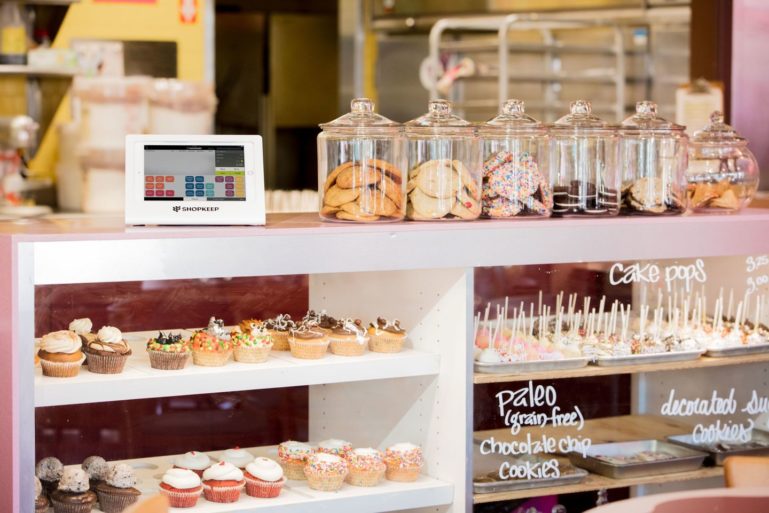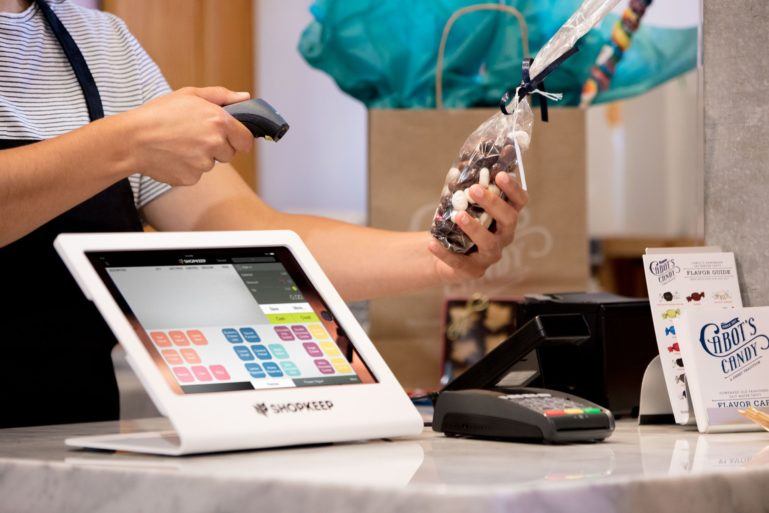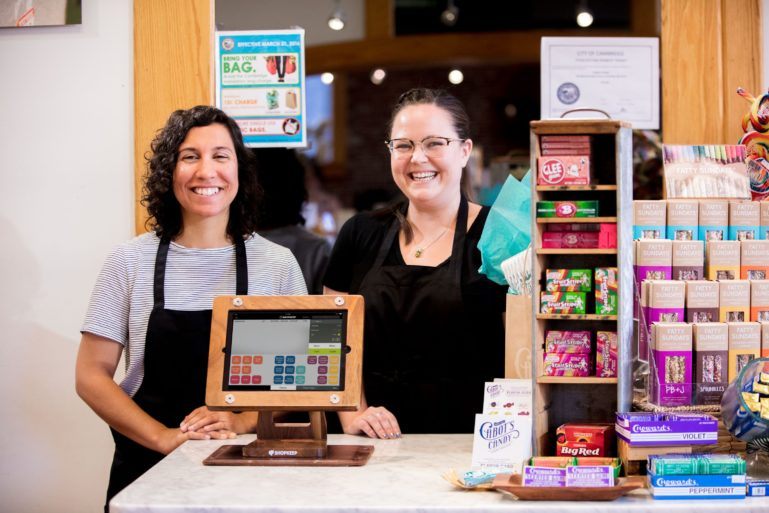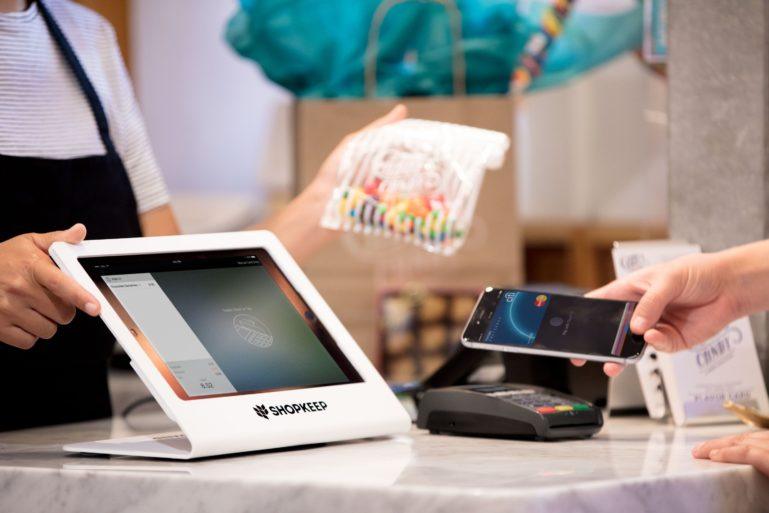
POS System Meaning: The Vocabulary You Need To Know
Are you in the market for a point of sale (POS) or just confused by what the term POS means? If you find yourself perplexed by the payment industry’s technical jargon, read on.
If this sounds like you, the good news is you’re not alone. The even better news is that we’re going to clear up all the complexities of what a point of sale actually is, explain the software that powers it, and share examples of the hardware that works in conjunction with the software to give you a complete solution.
If you don’t live and breathe POS systems like we do at ShopKeep, it’s easy to get confused by industry terms and all the moving parts that create a complete POS solution. Whether you’re in the market for a restaurant POS or a retail solution, there’s industry lingo you’ll want to be familiar with. Understanding this lingo will allow you to have educated and productive conversations with POS vendors, so you can quickly zero in on the system that’s right for you. We understand that as a small business owner, you’re time-strapped; that’s why we’ve done the heavy lifting for you. We’ve defined many of the standard terms you’ll come across during your search for the best point of sale system.
Let’s get started.
B.S. is for Barcode Scanners (Not Bull Sh*t)
Barcode scanners are an excellent way for cashiers to get customers through the checkout process quickly. They also have a bonus use that will save a lot of time when it comes to inventory management. As you’re checking in items from an inventory delivery, you can quickly scan the product and merely adjust the item quantity in the POS software.
Barcode Scanner
Sometimes referred to as a barcode reader, a barcode scanner is an electronic input device used to capture and read the information contained in a barcode or QR code. It then takes the data and transmits it to the POS software, so the corresponding item from the inventory database is added to the order. The scanner is connected to the POS either with a USB or Bluetooth connection.
1D Barcode Scanner
A one-dimensional barcode scanner is used to scan linear Universal Product Codes (UPC) on consumer goods in a retail environment.
2D Barcode Scanner
A two-dimensional barcode scanner is used to scan more complex codes such as Data Matrix, QR Code, and PDF417. The most common use in a storefront is scanning 2D barcodes on a driver license for age verification.

C.C.R. is for Credit Card Reader (Not Creedence Clearwater Revival)
Since more and more consumers are paying with plastic for everyday purchases, you’ll need a piece of equipment to process credit and debit card transactions.
Credit Card Terminal
A credit card terminal is a generic catchall term used to describe any payment acceptance device used to process credit or debit card transactions. It can be anything from a mobile device to a traditional Ethernet device found in most brick-and-mortar stores.
EMV Card Reader
An EMV card reader is a device that can process chip-based credit and debit card transactions. Most EMV readers can process magstripe (swipe) and Personal Identification Number (PIN) transactions as well. They can be mobile devices that are connected to the POS via Bluetooth or countertop versions connected via Ethernet.
Magstripe Card Reader
Sometimes referred to as a swipe reader, a magstripe card reader is a credit card reader that can only process cards with a magnetic stripe on the back. EMV and PIN transactions are not accepted on this device. For restaurant POS systems, they are typically found attached to the side of a touchscreen monitor.
PIN Pad
A PIN (Personal Identification Number) pad is an electronic device used to capture, accept, and encrypt a customer’s PIN during a credit or debit card transaction. In the context of POS, they are offered as a standalone device or as part of a unit that is also a magstripe and EMV reader in one such as the Ingenico iPP 350.
C.D. is for Cash Drawers (Not Compact Discs)
Since cash isn’t dead, all cash registers or point of sale systems need a cash drawer to store the bills and coins during a shift.
Cash Drawer
A mechanical device that is used to store coins, bills, and credit card receipts. A cash drawer works in conjunction with a cash register or point of sale software and can range in size from 13”(W) x 13”(D) – 18”(W) x 16”(D).
Cash Register Tray
These are inserts that go into the cash drawer. They include numerous bill tray and coin tray compartments to store and organize different monetary denominations.
The number of bill and coin tray compartments will vary depending on the size of the cash drawer. Smaller cash drawers may only have four or five coin and bill compartments, while larger drawers may have six to eight compartments.
Cash drawers will come with one cash register tray, but it’s always smart to purchase a couple of extra, so when you change drawers at the end of a shift, you can quickly do so with the extra inserts.

R.P. is for Receipt Printers (Not Record Player)
Even though email receipts or text receipts are becoming more popular and widely accepted, there is still a significant need for receipt printers in retail and restaurant industries. From sales receipts to ticket printing, receipt printers aren’t going anywhere anytime soon.
Impact Printer
Sometimes referred to as a transfer or dot-matrix printer, impact printers can use either wax, resin, or an ink-soaked ribbon that comes in the form of a cartridge and drops into the printer (similar to ink cartridges in a computer printer) to print receipts and tickets. They are called impact printers because the print head makes an impact on the ribbon and against the paper to print the text and images.
Impact printers are most often used as kitchen printers because they can withstand higher temperatures without affecting the printing ability.
Thermal Receipt Printer
Sometimes referred to as a direct printer, thermal receipt printers use heat to imprint text or images against a special kind of paper. These are the most common types of receipt printers used at the point of purchase. They are quiet, fast, efficient, and cost-effective since they use a direct heat source, rather than ink to print.
You can also use them as a kitchen printer to print order tickets from the point of sale. However, it’s not the best solution. Since the device uses heat as the printing source, if the temperature gets too hot in the kitchen, you’ll end up with illegible charcoal-looking tickets.
Touchscreens are for Tap-Tap-Tapping
Monitors and touchscreens are the primary way that you and your team will interact with your POS system. In some instances, customers may even use them to sign for credit card transactions, leave tips, or to select whether they want a printed or emailed receipt.
Some monitors connect to a separate computing device, while others have a CPU built right in. A smartphone or tablet is an excellent example of the latter.
All-in-One Touchscreen Computer
All-in-one, or AIO for short, is a computer, packed into a touchscreen monitor made for commercial use in self-service kiosks, retail stores, full-service restaurants and bars (FSRB), or quick-service restaurants (QSR). Traditionally, legacy POS software that is Windows-based or proprietary software systems leverage an AIO solution.
Tablet
A handheld, touchscreen computing device for cloud-based point of sale systems and other business applications that operate on Android, iOS, or Windows systems. They come in a variety of sizes ranging from a 5” – 12” screen size.
Touchscreen Monitor
A touchscreen is an input/output device that connects to a separate computer via VGA or HDMI cable and is a visual display and control center for computer programs such as point of sale.
Think of it as a traditional desktop computer setup. You have a monitor that connects to a separate computer tower, and you control it with a mouse and keyboard. Except, in this case, you control it by touch.
Monitors used in conjunction with industrial computers as two critical components of a traditional POS setup.

M is for Miscellaneous (And Mindful Merchant)
Since the goal is to make this piece as comprehensive as possible, here are a few miscellaneous items that are still important to remember.
Cash Register
The traditional definition of a cash register is a device used to register and calculate transactions at the point of purchase. However, over the years as they’ve evolved from mechanical to Electronic Cash Registers (ECR) to POS terminals and POS software, the term has become a catchall for those mentioned above.
Customer Display
Sometimes referred to as a pole display or customer-facing display, this is an electronic device used to display transactional activity at the point of purchase. In some states, like California, there’s a law that requires businesses to conspicuously display, to the customer, the price of each item being rung up.
Industrial Computer
These are rugged computers that you can configure with a variety of specs such as processing speed, storage (memory), operating system, and connectivity such as Bluetooth or WiFi capabilities depending on your specific needs.
It’s similar to buying a personal computer from a manufacturer like Dell or Hewlett Packard (HP). Unless you’re a Mac user, PC manufacturers typically will allow you to customize similar specs when you purchase a computer directly from them.
Industrial computers are used in conjunction with touchscreen monitors and ruggedly built to withstand the harsh conditions of a restaurant or retail environment such as extreme temperatures or storage in a dusty corner.
P.O.S. is for Point of Sale (Not Piece of Sh*t)
Now that you understand the hardware components let’s talk about software; which is the most significant part of finding the best POS system for your small business. Although some POS software can squarely be a piece of sh*t, not all of them are. That’s why we urge you to keep reading, so you’re more knowledgeable about point of sale. The more you know about POS, the easier it will be to weed out the sh*tty solutions.
A complete point of sale system is made up of hardware, which are the peripherals we discussed at the beginning of this post, and software. The software is the brains behind the entire operation.
It’s responsible for tracking inventory, so you never run out of stock on your most popular items. It can record employee hours, so you always have real-time insight into labor costs. It can track customer information along with purchase history to help with your marketing initiatives. And best of all, it will take all those data points, and more, and package them into detailed reports – so you can make smarter, data-driven decisions about your small business.
Along with understanding how the software functions, there is some jargon you’ll need to know. Let’s tackle the point of sale software related terms.
Legacy POS
Legacy POS, also referred to as on-premise POS, uses a traditional software distribution model. With legacy POS systems, the point of sale software program is installed on a local server or an industrial computer like we previously mentioned. Because of this, the POS software and any associated data, like sales records, can only be accessed when you’re in front of that computer or connected to the local server.
The best way to visualize this is to picture yourself saving a file on the desktop of your laptop. You can only access the file from that computer – unless you use a remote access tool, but that’s an entirely separate conversation. So, if you’re at work and you need a file from your laptop that is sitting at home, you’re SOL (Sh*t Out of Luck).
You’re also SOL because you’ll pay close to a thousand dollars or more, up-front, for the one-time purchase of the software. If the POS provider makes software updates and improvements in the future, those will cost you extra; as will customer support.
Cloud-Based POS
A cloud-based POS system is the opposite of a legacy POS. Rather than information stored on a local device in your storefront, with a cloud solution, data is stored on remote servers (these are maintained by the POS vendor) and the software is accessed via the internet.
Since you access the software and data from the internet, that’s means you can access it from practically anywhere, at any time. From home or at the beach, you can see what’s happening in your store without actually being there, and that’s peace of mind for any business owner.
In today’s fast-paced, mobile world, cloud-based systems like ShopKeep’s iPad POS, are becoming the new ‘norm’ for point of sale software. Cloud solutions use a Software-as-a-Service (SaaS) business model where you pay a small recurring monthly fee, and it includes all the updates and customer support you’ll need; at no additional cost.
Mobile POS
Mobile POS (mPOS) systems pair cloud-based software with dedicated mobile devices such as smartphones or tablets to perform functions of a point of sale system. It might be a native application that you download from the app store or a web-based POS solution that you access from the device browser.
Many cloud solutions are designed specifically for mobile devices. Therefore, providers often advertise them as mPOS, so the consumer understands there is a level of mobility with the software solution. Since mPOS solutions are a newer and more modern development, they are often far more user-friendly than legacy POS systems.
SEE ALSO: Small Business Basics: What Is POS Software?
F. F. is for Features and Functionality (Not Foo Fighters)
In addition to deciding on a legacy system or a cloud-based solution, features are going to be a primary focus when choosing a POS system. Features are inherent in point of sale systems while others communicate via integration to 3rd party software applications.
Accounting Software
Software used to streamline business accounting processes. Many point of sale systems will have an integration with a third-party small business accounting solution like QuickBooks, while others may have a simple general ledger or invoicing software built into the POS.
Customer Database
A customer database stores customer contact information such as an email address and phone number. Some databases can also track customer purchase history which is especially useful for marketing initiatives.
Email Marketing
Email marketing is the digital version of traditional postcard marketing. Most POS systems integrate with a 3rd party email marketing platform such as MailChimp. Capture customer email addresses at the point of purchase and build your email list to send out special promotions or newsletters to keep your customers engaged.
Employee Management
These tools cover the process of managing employees such as contact information for easy access, shifts for reporting and accountability, scheduling, and labor cost for payroll. Knowing your real-time cost of labor will help you ensure you keep a healthy bottom line. Depending on the specific industry, payroll cost can range from 10 – 40 percent.
Inventory Management
The process of managing inventory such as controlling and tracking the transfer of goods from initial order to customer purchase. Managing quantities on-hand, item cost, retail price, and everything in between.
SEE ALSO: Basic Inventory Management Techniques for a Better Business
Loyalty Program
Piggybacking off of a customer database are loyalty programs. Loyalty programs keep track of customer information and purchase history like a customer database, but it also allows you to build loyalty campaigns as an incentive to drive and reward customers for their loyal buying habits.
A typical example is for customers to earn points for every dollar they spend. Once they reach a spend threshold, they’ll receive a reward such as a discount on their next purchase.
Credit Card Processing
Credit card processing is an extensive topic so, in this context, we’re going to provide a birds-eye overview. If you want to learn about the complete ins and outs of credit card processing, check out our blog post, How to Accept Credit Card Payments – The Ultimate Guide.
At a high level, credit card processing is a service that allows merchants to accept credit and debit cards at the point of purchase. From the money collected from payment card sales, a small percentage, such as interchange-plus rates are, paid to the Merchant Service Provider (MSP) and card networks, and the remainder is deposited directly into the merchant’s bank account.
SEE ALSO: Credit Card Processing Fees: What You Need to Know
Gift Card Processing
Store-branded gift card processing is a lot like credit card processing. You need a gift card service provider so that you can add and subtract value for cards purchased and redeemed at the point of sale.
The big difference between store-branded gift cards and gift cards with a card network logo like Visa or Mastercard, is that store cards operate on a closed-loop network; meaning the communication and exchange of money only exist between you, the provider and your customers.
Gift card sales are increasing year-over-year, and retailers and restaurants are dominating the most popular gift cards by category. They’re a great alternative to paper gift certificates that have to be redeemed manually and integrate with your POS software.

Ecommerce Integration
Ecommerce integration is a connection between your POS solution and a 3rd party ecommerce platform. There is direct, real-time communication between both channels so you can manage both your physical inventory and your online merchandise from one central location.
Online Ordering Integration
The ecommerce equivalent for the foodservice industry is online ordering. Online ordering is a connection between your point of sale system and a 3rd party online ordering platform. It is direct, real-time communication between both channels so when a customer places an online order, it will print to the designated receipt printer within the POS network.
Reporting and Data Analytics
Sales reports and analytics are necessary to understand the overall health and performance of your small business. When looking for a POS system, it’s not about the number of reports the solution has to offer, but the quality of those reports. Here are a few you’ll want to have:
- Overall sales report
- Sales report by item, department, and category
- Sales report by tender type
- Employee reports
- Shift reports (X reports, Z reports)
- Inventory reorder reports
- Customer reports
- Supplier reports
Find Your POS System
Now that you know standard POS terms, their meaning and their place within the point of sale ecosystem take some time to think about what type of POS system will be the best solution for your business. What are some factors you consider essential and ones that will help you run a more efficient operation? Once you have those answers, you’ll have successfully defined your POS system meaning, and you can begin vetting POS solution providers. Now go out and get started!
Want to try ShopKeep for yourself?
Just answer a few easy questions.
Need help finding the right point of sale?
Just complete the form. We’ll call you right back to explain how ShopKeep can work for you.
Hit the ground running.Sprinting, in fact!
Read our free, comprehensive guide, Small Business 101, to learn all you need to know about starting a thriving business.

